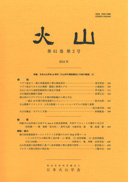巻号一覧

前身誌
41 巻, 1 号
選択された号の論文の5件中1~5を表示しています
- |<
- <
- 1
- >
- >|
-
小室 裕明, 志知 龍一, 和田 浩之, 糸井 理樹原稿種別: 論説
1996 年41 巻1 号 p. 1-10
発行日: 1996/03/05
公開日: 2017/03/20
ジャーナル フリーSanbe Volcano is a large lava dome, 2 km in diameter, emplaced at the center of an elliptical caldera with a long axis of 7 km and a short axis of 5 km. One crater is exposed in the center of this dome, and four peaks surround this crater. However, the basement depth of the caldera has not been determined. We have made gravity measurements around Mt. Sanbe in order to investigate the caldera morphology. The residual gravity anomaly (which is obtained after the regional gravity trend is taken away from the Bouguer anomaly, assumed to be 2.67 g/cm3 in density) is low at the center of Sanbe Caldera. Mass deficiency, estimated by Gauss's theorem, indicates that Sanbe Caldera is one of the low anomaly type calderas, as large as the Mashu caldera. Basement depression under Sanbe Caldera has been determined by three dimensional analysis, when the density contrast between the basement rocks and Sanbe volcanic rocks is 0.43 g/cm3. The depression is square shaped, with a steep rim and a flat floor. The square outline suggests that the depression part may be subsided along normal faults ; accordingly this caldera may have originated in a cauldron. The western and eastern rims of the depression correspond to the somma, but the northern and southern rims are discordant. The poor topographic expression in these areas may be due to collapse of the caldera walls. The deepest part of the basement is centered on the east side of the present crater. This deep center may be the only vent of Sanbe Volcano, because other depressions are not observed beneath the lava dome.抄録全体を表示PDF形式でダウンロード (886K) -
須藤 靖明, 岡本 茂, 筒井 智樹原稿種別: 論説
1996 年41 巻1 号 p. 11-22
発行日: 1996/03/05
公開日: 2017/03/20
ジャーナル フリーThe Kuju active volcanic region locates in the central Kyushu graben area. To investigate the upper crustal structure beneath this volcanic region, the seismic network (7 stations) was newly established and the earthquakes which occurred in and around Kyushu Island were observed. Since the observational condition of each seismic station was not same, the corrections of site-effects and other seismic recording circumstances were performed to be enabled to compare and examine the seimic waves recorded at each station. As a result, the amplitudes of seismic waves which passed through the Kuju volcanic region were recognized to be obviously attenuated. The attenuating region located in the area of 5-15 km northward from Mt. Kuju and in the depth of 5-20 km. The average Q-values between 2 seismic stations could be obtained from the spectral ratios of seismic waves. The Q-values were estimated 50-100 level at the attenuating region. At the non-attenuating region the values were above 200-500. Because these Q-values are average at the ray paths between the seismic stations, the Q-values at the attenuating region are anticipated to become locally more little value. The location of the attenuating region coincides with the negative Bouguer gravity anomaly area and the low seismic active area. It is indicated that, beneath the northern part of the Kuju active volcanic region, there are the presence of seismic wave attenating, low density and brittle materials.抄録全体を表示PDF形式でダウンロード (1124K) -
神宮司 元治, 江原 幸雄原稿種別: 論説
1996 年41 巻1 号 p. 23-29
発行日: 1996/03/05
公開日: 2017/03/20
ジャーナル フリーA quantitative analysis method to estimate steam and heat discharge rates by remote sensing technique was developed, based on the theory of diffusion of volcanic steam. The visible maximum diameter of volcanic steam is related to the full width half maximum of the steam density distribution. The steam density at the center of the visible maximum diameter can be derived theoretically assuming Gaussian distribution of steam density. So, we can calculate the volcanic steam discharge rate, if we also know the velocity of rising steam. To realize the theory, we developed an analyzing system based on the theory using compact video camera and personal computer. This system can deal with many data of video pictures in a short analyzing time. To confirm the effectiveness of the method, we applied it to an actual steam well and obtained good coincidence between steam discharge rates from the new remote sensing method and the conventional direct method. We also applied the remote sensing method to estimate steam and heat discharge rates from an active volcano of which steam and heat discharge rates are known. As a result, we obtained reasonable values from the volcano.抄録全体を表示PDF形式でダウンロード (20505K) -
In-Woo LEE原稿種別: Letter
1996 年41 巻1 号 p. 31-34
発行日: 1996/03/05
公開日: 2017/03/20
ジャーナル フリーPDF形式でダウンロード (3389K) -
浜口 博之, 石原 和弘, 清水 洋原稿種別: 解説・紹介
1996 年41 巻1 号 p. 35-37
発行日: 1996/03/05
公開日: 2017/03/20
ジャーナル フリーPDF形式でダウンロード (250K)
- |<
- <
- 1
- >
- >|